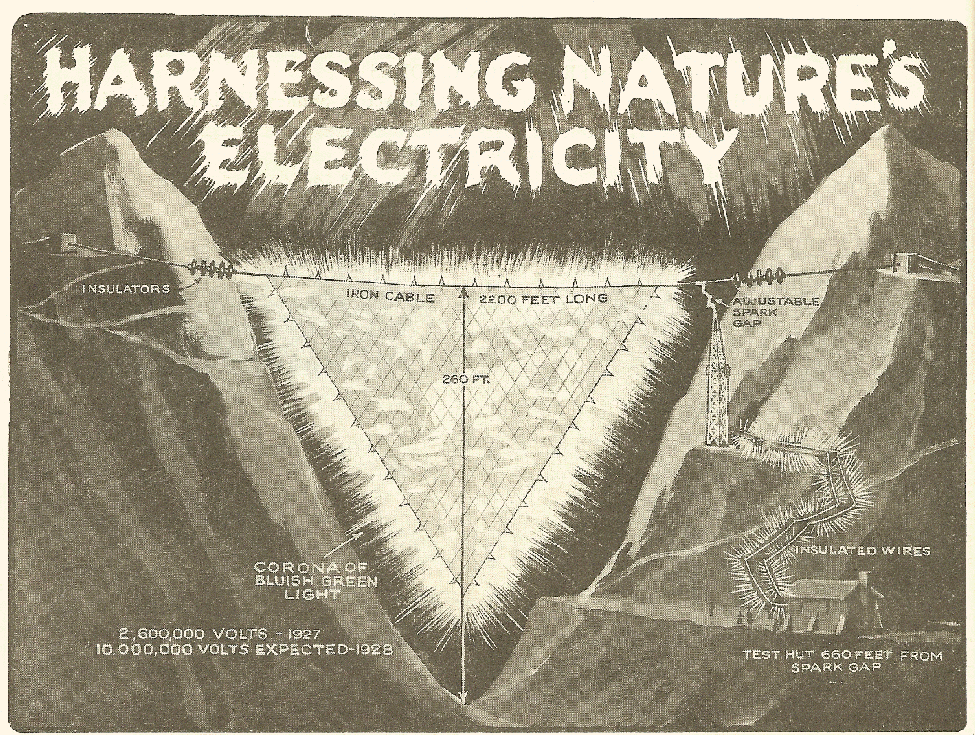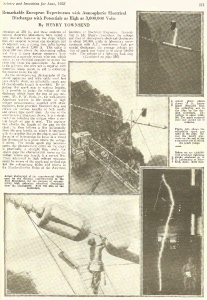Remarkable European Experiments with Atmospheric Voltage Electrical Discharges with Potentials as High as 3,000,000 Volts
An article about three German studends who experiment with obtaining electrical energy from the air, the methods and the system they use, and how the electrical discharges are measured.

The above scene shows the remarkable electrical effect which frequently occurs in the Als mountains, where three young German scientists are endeavoring to extract tremendous electrical discharges from the atmosphere. The idea behind these experiments is that man may find a way to disintegrate the atom, and thus unlock a tremendous new source of energy.
BENJAMIN FRANKLIN, fired the imagination of electrical engineers and experimenters all over the world for a century beyond his time, when on an immortal day he demonstrated by means of his kite, that lighting was a natural electrical phenomenon. Every student or electrical ma..ers has at some time or other dreamed of utilizing the gigantic electrical charges which are ever present in the atmosphere surrounding our earth. Several scientist have lost their lives while trying to harness the tremendous electrical discharges in the form of lightning. Last summer and again this summer, three young German scientists, A. Brasch, F. Lange and C. Urban of the University of Berlin, aided by all the latest scientific information as to how to protect themselves, will attempt to measure and chart the atmospheric electrical discharges high up in the Alps.
These daring young scientists found in last summer’s experiments that electrical sparks of great intensity and accompanied with a roar like that of huge cannon, jumped the gap of their apparatas repeatedly, even when no electrical storms were in the vicinity. On several occasions electrical sparks jumped the large gap on an average of one every second for thirty minutes, and these discharges averaged two million volts. A beautiful corona of bluish-green color played around the cable and wire net at night. The cable and net were suspended across the valley between two peaks in the Alps, as the accompanying pictures show. This corona had all the appearances of the Aurora Borealis, that most magnificent electrical display observable in the arctic regions particularly.
In last year’s experiments, the three scientists measured atmospheric discharges having potentials as high as 2,600,000 volts, when the summer electrical stoms were practically over; it is hoped this year within the improved apparatus to measure potentials up to ten or more million volts. I t is known that potentials of from 5,000,000 up to 30,000,000 volts passes to earth from an elevation of 250 ft., and these students of natural electrical phenomena have found a very desirable location in the Alps, where they can suspend between one mountain and adjacent one, a strong iron cable having a length of about 2,000 ft. This cable is about 250 feet above the intervening valley, and from it these daring engineers have suspended a coarsely woven wire net, which serves as an electrical capacity to gather the electricity from the atmosphere. As shown in the pictures, the wire net is supplied with numerous sharp points to aid in collecting the current form the air.
As the accompanying photographs of the actual apparatus and wire cable used last year clearly show, an adjustable spark gap of considerable length is provided. By adjusting this spark gap to various lengths, it is possible to judge the voltage of the discharge wich leaps the gap at any moment. Mr. F. W. Peek, Jr., the well-known American worker in the realm of high voltage measurements, together with other engineers, have provided tabulated data and curves for various lengths of both needle and sphere type spark gaps. As one of the accompanying diagrams shows, it is a simple matter to calculate the voltage when a certain length of gap is used. The engineer first checks the lengths of the gap on the chart; he then follows a line horizontally from the gap length to where in intersects with the angular line on the chart; and from the point of intersection he looks in a visual line downward to a place where the voltage is given. For needle spark gap measurements, the characteristic curve on the chart is practically a straight line, while for sphere gaps the characteristic curve on the voltage versus gap length, is a curved line. Those interested in high voltage measurements by means of the spark gap method can find the voltage-gap tables and charges in the Standardization Rules of the American Institute of Electrical Engineers. According to Mr. Peek’s researches, the voltage er foot of atmospheric electrical discharge is about 100,000, while in laboratory measurements with A.C., transformer high potential discharges, the average voltage per foot of spark was found to be about 150,000 volts. The voltage of a lightning flash may easily be 100,000,000 volts, as Mr. Peek has pointe out in one of his scientific papers.
WHY THE EXPERIMENTS ARE BEING MADE
One of the main reasons why these dangerous experiments are being carried on by the three young German scientists, whose names we have already learned, is because science believes that with a sufficiently hight voltage, it will be possible for man to disintegrate the atom, and in this way make available a tremendous source of power as yet untapped. These experts have calculated that they will be able to obtain electrical energy in sufficient quantity from one of these powerful atmospheric discharges, to equal the Alpha rays obtained from 220 pounds of radium. As we have monitored before, these experiments are of course fraught with great danger, and for that reason the experimenters seek refuge in a special lightning-proof hut, which is located about 600 ft. from the spark gap. When electrical storms are in the vicinity, it is especially important that the scientist keep within their protected fortress, for otherwise they would very probably be killed by a stray electrical discharge.
One of the peculiar things about this whole line of experiment is that the average layman does mot realize perhaps, that there is a high electrical stress in the atmosphere on clear days, as well as when thunder stoms are overhead. This fact has been known for a hundred years and more, and many years, ago measurements of the various electrical potentials at increasing altitudes, were observed and measured by scientifica investigators. There are a number of different ways in which these high electrical potentials found in the atmosphere can be measured: one of these methods involves the use of a calibrated spark gap. In this case the gap is set to a predetermined length, and when a discharge jumps this gap, the engineers know of course from previous experience and measurements, just what voltage is present. Another method of measuring extra high potentials, such as here , required the use of a static volt-meter, which involves the use of a stationary and of a movable or rotary set of metal plates, forcing a condenser, to which an needle is attached. For voltages above 2,000, static voltmeters have been used in a great many American central stations, and they have many desirable and useful characteristics. Of course as the voltage to be measured increases, the space between the quadrant shaped stationary and movable plates in increased and vice versa. The electrostatic field from voltages below 2,000 is not sufficient to warrant the use of a static voltmeter. Another method of measuring high potentials involves the use of the so-called vacuum tube voltmeter.
The general characteristics of the atmosphere electrical discharges, including lightning, have been measured and recorded by one of the newest scientific instruments, knows as the cathode ray oscillograph. By means of this quite remarkable, high voltage scientific apparatus, Mr. Peek, one of the well-known General Electric Company staff of research engineers, has made some very interesting and remarkable discoveries concerning the nature of natural electrical discharges, particularly of lightning discharges. Many people will probably wonder why Mr. Peek and some of his colleagues in the engineering profession, including the three daring German students, Messrs, Brasch, Lange and Urban, play with such dangerous electrical discharges, and why they are at all interested in them. We explained previously why their German are intent on finding out all they can about these tremendous voltages obtained from the atmosphere, while Mr. Peek, we may say, also has a very practical reason for carrying on experiments with these death-dealing bolts of Thor. Mr. Peek has been for many years intent on finding out what causes the huge insulators on long distance, high potential transmission lines to break down when electrical stoms break loose over these regions.











